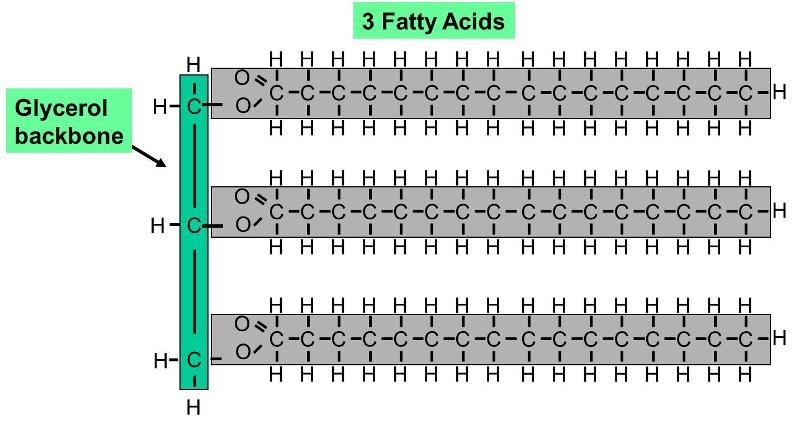Three Fatty Acids Attached to a Glycerol Backbone
Within an individual glycerophospholipid fatty acids are attached to the first and second carbons and the phosphate group is attached to the third carbon of the glycerol backbone. Saturated fatty acids do not contain any double bonds along.

1 The Triacylglycerol Molecule Consists Of One Glycerol Backbone Download Scientific Diagram
The most commonly added alcohols serine ethanolamine and choline also contain nitrogen that may be positively charged whereas glycerol and inositol do not.

. Chapter 10 will focus more on the formation of the ester bonds. The presence of double bonds can vary within fatty acids. Water is a product in the chemical reaction of peptide bond formation.
The position of each carbon atom in the backbone of a fatty acid is usually indicated by counting from 1 at the COOH end. When synthesis is complete the free fatty acids are nearly always combined with glycerol three fatty acids to one glycerol molecule to form triglycerides the main storage form of fatty acids and thus of energy in animals. They are molecules made of fatty acids chain-like molecules of carbon hydrogen and oxygen linked in groups of three to a backbone of glycerol.
A phospholipid molecule is composed of a glycerol backbone attached to two fatty acid groups along with a phosphate group. Molecules with three fatty acids attached to a glycerol backbone. Each of the three carbons comprising the glycerol molecule allows for a stereochemically distinct fatty acid bond position.
The major classifications of phospholipids are the phosphatidylserines PS the. Lipids or fats consisting of three fatty acid chains attached to a glycerol backbone. A range of saturated bicyclic fatty acids was also produced from the cyclic monoenes by formation of a bridge across a cyclopentyl or cyclohexyl ring.
Nucleotides are building blocks of nucleic acids DNA and RNAA nucleic acid contains a chain of nucleotides linked together with covalent bonds to form a sugar-phosphate backbone with protruding nitrogenous bases. TAGs as shown in figure 810 are built from one molecule of glycerol and three molecules of fatty acids that are linked together by an ester bond. For example DNA contains two such chains spiraling round each other in the famous double helix shape.
Fatty Acids Glycerol Hydrophilic Hydrophobic Phospholipids Sterols Triglycerides. When foods containing fats are consumed the fatty acids are separated from their glycerol backbone during the process of digestion. Phospholipid is a type of lipid composed of a phosphate group attached to a glycerol backbone.
Triacylglycerol is composed of three fatty acids esterified to a glycerol molecule Figure 4. In the net reaction two amino acids join together and produce one water molecule to form a peptide bond. Most phospholipids have a saturated fatty acid on C-1 and an unsaturated fatty acid on C-2 of the glycerol backbone.
Fats and oils in the diet are thus available to the body as fatty acids. Cyclopentenyl fatty acids were apparently formed by cyclization from one double bond to the other while cyclopentyl and cyclohexyl fatty acids were formed by cyclization in a direction away from the existing double bond. Lipid consisting of a single fatty acid chain attached to a glycerol backbone.
In these compounds the three hydroxyl groups of glycerol are each esterified typically by different fatty acids. In this section we will focus on the structure of the long fatty acid tails which can be composed of alkane or alkene structures. Similar to simple fatty acids the length of the fatty acid group determines the nomenclature of short-chain triglycerides SCTs medium-chain triglycerides MCTs and long-chain triglycerides LCTs.
Specifically a peptide bond in a protein is formed by condensation of amino acids. In the reverse reactions biopolymers are degraded by hydrolysis reactions which chemically consume water. Lipid bilayer encircles a cell and is amphipathic with one end as a hydrophilic head and the other end as a hydrophobic.
Glycerolipids are composed of mono- di- and tri-substituted glycerols the best-known being the fatty acid triesters of glycerol called triglyceridesThe word triacylglycerol is sometimes used synonymously with triglyceride. Glycerol is a three-carbon molecule that forms the backbone of membrane lipids. The physical properties of the triacylglycerol are determined by the specific fatty acids esterified to the glycerol moiety and the actual position the fatty acids occupy.
Enzymes released from the pancreas that digest lipids in the diet.
1 The Triacylglycerol Molecule Consists Of One Glycerol Backbone Download Scientific Diagram


No comments for "Three Fatty Acids Attached to a Glycerol Backbone"
Post a Comment